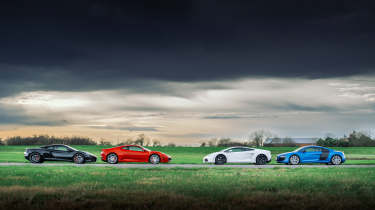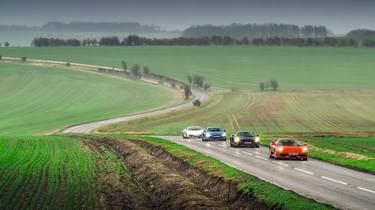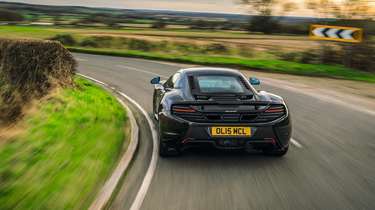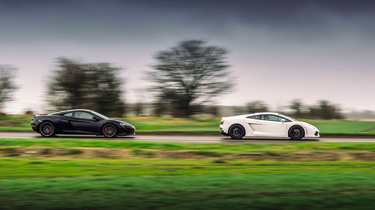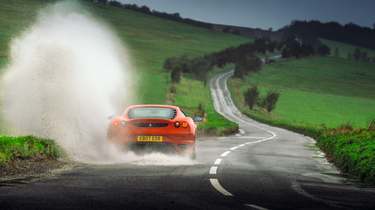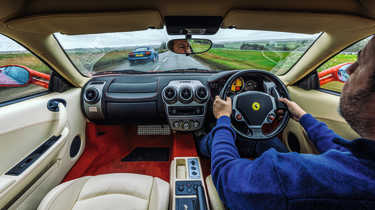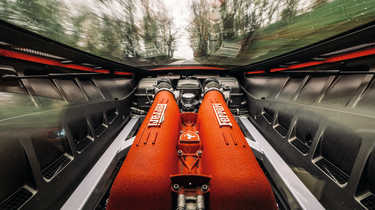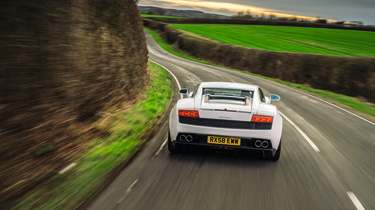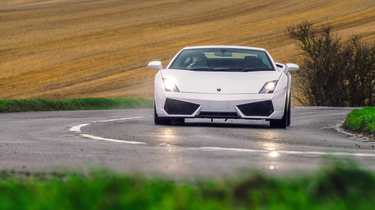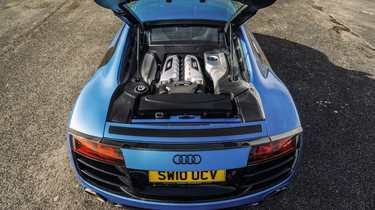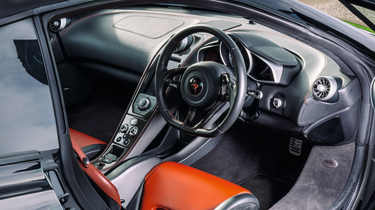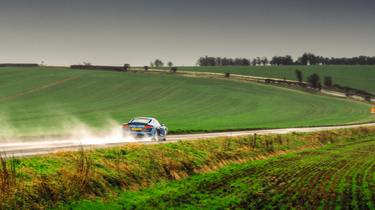Ferrari F430 v Lamborghini Gallardo v McLaren 650S v Audi R8: The best used mid-engined supercars
For most of us, owning a mid-engined supercar is the ultimate. And because of the numbers built in the last 20 years, the dream is more attainable than ever. Ferrari F430, Lamborghini Gallardo, McLaren 650S or Audi R8 V10? We help you choose
As automotive rites of passage go, owning a mid‑engined car has to be right up there with the best. Make it a mid-engined supercar and there’s surely little to touch it. For many decades, whether you were buying new or used, it almost certainly meant buying Italian, which exposed you to engine-out servicing for everything but emptying the ashtrays. Thankfully in more recent years the genre has moved on, with models becoming more diverse, more reliable, more useable and – crucially for attainability – far more numerous.
Such abundance has transformed the used market, as has the growing network of excellent specialists to maintain them at less than main dealer rates. As a result the mid-engined supercar dream has become viable for more of us than ever before. It’s certainly a nice thought to entertain. But which cars to consider?
> Why now is the time to buy your dream used car
Well, you couldn’t have a mid-engined supercar test without a Ferrari, and the F430 nicely blurs the boundary between classic and modern. Stick-shift cars are rare and command a significant premium, so we’ve gone with the far more abundant F1 paddleshift model, values of which seem to sit somewhere between £75,000 and £85,000 for good useable examples. Spiders seem far more numerous in the classifieds than berlinettas, but we’ve gone with the latter because we’re coupe kinda guys.
For many the supercar fantasy is very definitely a Raging Bull and not a Prancing Horse. We chose a Gallardo LP560-4 because it’s more of a plug-and-play proposition than the early 5-litre cars, the original Lambo V10 being potentially more problematic and needing more TLC than the later Audi-fied 5.2-litre ten-banger. As with the F430 there seems to be at least four Spyders for sale for every coupe, but when you do find a tin-top the pricing is in a similar ballpark to the F430.
Special editions such as the rear-drive Balboni are too expensive and too hard to find, especially the handful that were spec’d with a manual gearbox. This is no bad thing because it means we’ll be revisiting two of the more formative single-clutch paddleshift transmissions. Cutting-edge in their day, will progress throw unflattering light on these sequential manuals?
Audi’s R8 has always been something of an interloper. Especially the V10 FSI, which combined a truly exotic powertrain with reassuring Teutonic sensibilities and the ruthless resolve so typical of the Piech-led VW-Audi Group of the day. Until the second-gen cars, all R8s were quattro four-wheel drive. Manual V10s are far more abundant than their Italian equivalents, yet the R8 remains a rare car. It says a lot for brand snobbery/petrolhead psyche that they are much more affordable, with decent manual R8 V10 coupes available for less than £50k.
Such has been McLaren’s output we had at least four models to choose from (not including Spider derivatives) that fitted our test criteria. We considered the 12C, but its significance and desirability are for being the first of McLaren Automotive’s mid-engined models rather than the best to drive. In the end we settled upon the 650S because McLaren’s relentless arc of improvement means the newer the car the higher its resolution.
It seems nuts that prices for these striking machines start in the mid-70s and seem to top-out at just under £100k (this heavily MSO’d, as-new, 5000-mile example being an exception), but heavy depreciation seems to be the price first owners pay for McLaren’s product churn rate and over-reliance upon variations of the same powertrain. Their hit means rich pickings for subsequent buyers.
It’s one thing hatching a cunning plan in an editorial meeting, but quite another to make it happen. Especially when it relies upon sourcing privately owned cars, and especially when those cars are mid-engined exotics and its one of the wettest and most miserable Februarys on record. Fortunately owners of these cars are true enthusiasts, to the point where they’re prepared to rearrange their schedules to free-up two mid-week days with very little notice, or even more amazingly, let us take their cars away. We couldn’t have done this test without their generous co-operation. And we wouldn’t have found them without the help of Mike Wheeler at Rardley Motors (rardleymotors.com) and Ricky Elder at REPerformance (reperformance.co.uk). Gents, we owe you one.
After a cover shoot at Bedford and a night in Swindon at the Holiday Inn (if you’re location-hunting for a post-apocalyptic zombie movie, give them a call), we splash our way through torrential rain towards a location on The Ridgeway, hunting for the dreaded ‘Parrott Pin’ dropped to our WhatsApp group a scant few seconds before our departure. It’s a grim day but our dramatic convoy does its best to beat the gloom; fantastic shapes, bright colours and sizzling soundtracks injecting the kind of drama only a combined 2000bhp and 36 cylinders can. They look a million dollars, yet by my reckoning are actually worth half that.
Holding the key to a Ferrari is always a great way to start the day. The F430 is a pretty car but looks its age in this company, its deep flanks and more upright glasshouse lacking the contemporary style of the 650S, clean lines of the Lambo or seductive curves of the Audi. It’s still a looker, and the more time you spend with it the more you come to appreciate its lines and how it looks on the move.
Scarlet paint and magnolia hide is a classic combination. Such old-school glam is somewhat out of vogue but brings tremendous light and space to the cockpit. The view through the windscreen is panoramic thanks to a low scuttle, and the pointy door mirrors frame a great view of the side air intakes and road behind. It’s weirdly spacious though, which gives it a totally different feel to the capsule-like cockpits of current supercars.
Insert the ignition key (remember those), give it a twist and squeeze the brake pedal. Then push the shiny red button on the steering wheel and the starter chirrups momentarily before the naturally aspirated 483bhp V8 fires into life. It’s a raucous thing, a frenetic flare of revs rapidly settling into a deep, open-piped idle as streams of vapour spew from the quad tailpipes. God, I love supercar start-up rituals. Clicks and whirrs just aren’t going to cut it.
There’s a slightly brittle feel to the damping at lower speeds, which combined with the quick but slightly glassy steering means you feel your way into the F430’s responses and behaviour a little tentatively. The conditions don’t help of course, but stepping back a decade and a half is a sharp reminder of how much easier really fast cars are to drive these days.
The shift paddles are fixed high on the steering column, with a long pull and a smooth, deliberate action. The pedals are noticeably offset, the hard and slightly dead brake pedal placed unusually close to the throttle. Upshifts at lower speeds and rpms are a fraction lazy, but progress is easy enough. You can certainly see why newcomers to supercars were drawn to the simplicity of two-pedal driving.
With miles you begin to bond with the Ferrari. The engine is fabulous; characterful and nuanced, with impressive tractability and true ferocity when you wind the thin red needle around the deeply bezelled tacho. It’s a throwback to the days before turbocharging took over, the cammy crescendo and prickly soundtrack getting your heart pounding as only a Ferrari can.
The famous manettino made its mainstream debut on the F430, the little anodised lozenge serving as a dynamic dimmer switch to wind aggression into the car or dial it out as you wish. It doesn’t have the dramatic effect of contemporary and more digitised cars, but it definitely pumps a shot or two of espresso into the F430. It peps up the F1 gearbox, but ultimately fails to inject sufficient punch or incisiveness into the shifts. Drive it like a modern dual-clutch, keep the throttle pinned on upshifts and there’s a forced hesitation, but breath out of the throttle as you pull the upshift paddle and the process feels smoother with less torque interruption. It’s engaging in its own way, but I’d be lying if I didn’t admit the F1 transmission is a constant source of background disappointment.
Judged as a whole, once you understand the F430 you become far more comfortable with its flighty urgency. It points into corners beautifully and deals with the road surface effectively. There’s quite a bit of road noise, but if you filter out what you’re hearing and focus on what you’re feeling, the underlying composure is decent despite the feeling that the suspension never fully settles.
Handling-wise you sense the mass is centred, but your focus is on feeling how hard you’re loading the front end and whether the rear has the grip to live with it. It does, but this sense of rotational energy is down to the E-diff, which Ferrari debuted on the F430. If you want to make it slide you need to be on the ball, but the relatively torque-lite engine (343lb ft at 5250rpm) means you can ride things out on revs. Perhaps most importantly, the F430 feels light and agile at all times, exuding a vitality ordinary cars simply don’t possess.
Lamborghini has always been Ferrari’s nemesis, bad blood between Ferruccio and Enzo bound into the DNA of each brand. There’s less animosity now, but rarely do you find a fanatical member of both tribes. And it’s easy to see why when you step from the F430 to the Gallardo. Styling has always been a primary point of difference between the two marques, but so too has the driving experience. Rarely has that been better expressed than in the contrast between F430 and Gallardo. Brutally square-shouldered to the point of being brick-like, the Gallardo really is a magnificent piece of design. One that only looks better as time passes.
The interior is a mix of Lambo flourishes and Audi switchgear, with some shiny and slightly incongruous bits of bright trim. The view out is more satisfying, the plunging A-pillars, strange but very useful fixed quarter-lights and jutting door mirrors creating a vista of real drama. The deep dashboard accentuates the feeling of being sat in the centre of the car, the base of the screen well beyond arm’s reach.
The later 5.2-litre V10 fitted to this LP560-4 doesn’t quite have the snarling, grungy vocals of the original Lambo-powered 5-litre, but it still booms out a barrel-chested soundtrack as befits a car that develops 552bhp at 8000rpm. Like the F430, this Gallardo has a paddleshift transmission, as series production models dropped the manual when the 5.2-litre motor was adopted. Also single-clutch, the E-Gear ’box requires some patience if you’re to get on with it. Soft-shoeing the upshifts helps, but not as effectively as in the Ferrari, and full-bore shifts in Corsa mode are a bit more violent. It’s as I remember Gallardos in period, so all part of the authentic experience, but also a reminder that these single-clutch gearboxes were always work-in-progress, and why they ultimately got dropped in favour of DCT hardware.
Chassis-wise, the Gallardo is a little numb at lower speeds and feels heavier on its feet than the Ferrari. The steering is slower than you might expect, but there’s good bite from the front end, so confidence builds more readily. The all-wheel-drive system doesn’t feel the most natural, but there’s inherently more traction than the F430 possesses, which is welcome in these conditions.
Commit to a corner and the balance is nose-led, pushing into steadying understeer on a balanced throttle, but if you have the chance to hustle it harder you settle it into a more neutral stance, even getting the tail to feel like it’s taking the lead. You can make spectacular progress, and once you find the best way to manage the upshifts the Gallardo finds a hugely satisfying groove.
The engine is the star: big-hearted grunt (398lb ft) spliced with a top end that’s every bit as sharp as the Ferrari’s. Its performance feels bigger and more epic as a result, the early shove matched by an ever-increasing intensity as you work towards the 8500rpm red line. It sounds more exotic, too, the extra pair of cylinders creating more musical harmonics and plenty of volume, but crucially not all of the time.
Biggest bugbear for me are the brakes. Not for their stopping power, which is prodigious when you really haul on them, but for their lack of finesse when attempting to make measured inputs. Instead of a firm pedal and progressive response you have some initial soft, dead travel followed by more retardation than you wanted, which forces you to jump out of the pedal only to have to try and squeeze back in. However hard you try to compensate, it always makes your inputs feel clumsy.
Despite the flaws it’s hard not to fall for the Gallardo. You’d justifiably feel good about life if you had one in the garage, knowing few cars look or sound better or give more generously of the things only an Italian supercar can provide.
It would be easier to overlook the Lamborghini’s shortcomings if it wasn’t for our next car, the Audi R8 V10. The Germans don’t really ‘do’ supercars. It’s hard not to fall back on national stereotypes, but flamboyance is not a Teutonic trait. Witness the BMW M1, the mechanical modesty of which somehow managed to outweigh being built by Lamborghini and styled by Giugiaro. Even Porsche’s Carrera GT and 918 Spyder have a certain restraint about them.
The R8 is Audi’s glorious outlier. Born from brand ambition and realised through sheer engineering might, it was an instant icon. In earlier times it could have become one of those dynastic 911-esque models that morph through generation after generation. Instead, thanks to the forced transition from ICE to EV, the R8 has been cut off in its prime.
Rare, hand-built, mid-engined supercars with mega naturally aspirated engines and manual transmissions are rightly revered as the apex of the analogue driving experience. So how is it that V10 stick-shift R8s can be had for little more than new Golf R money? Snobbery. Lack of kudos. Lack of investment potential. For whatever reason, as much as the R8 excels as a supercar it has struggled to overcome the burden of its bread-and-butter badge.
Looking at this gorgeous Kingfisher Blue example it seems preposterous that anyone could seriously harbour the notion this is anything but a bona fide exotic. It really is an iconic design. There’s a pleasing restraint to the exterior and interior, but there’s ample presence and just enough occasion to add a frisson to every drive.
The earlier V8 always found more favour with us back in the day, on account of a slightly better handling balance and more delicate feel, but this V10 feels so good I’m beginning to question that long-held stance. Only in particular circumstances, specifically through repeated corner transitions, do you feel there’s more mass to contain. It certainly doesn’t offset the added drama of ten cylinders and an extra 100bhp.
The R8 also has a wonderful suppleness and pliancy that melts the road beneath you. Sport mode brings tighter control from the adaptive dampers but with none of the sharp-edged penalty you might expect. It’s a revelation. Where the Lamborghini feels a little remote, the Audi has more detail and warmth to the controls. The steering is a little slow, but because you’re getting more feedback you can feel the reserves of grip and traction more readily and therefore work up to those limits more quickly and precisely. You connect with it and trust it within the first few miles.
After working with, or rather around, the F1 and E-Gear transmissions it’s a delight to palm the R8’s open-gated gear lever, click-clacking up and down with total freedom and endless satisfaction. This car has an Akrapovic exhaust system, which doubtless liberates a few more horses (and decibels), but the V10 still feels slightly muted compared to the Gallardo’s, both in terms of performance and soundtrack. As-standard there was the best part of 40bhp between the more powerful Lambo and the Audi, so this would explain the difference in urgency, but the R8 still remains a seriously fast car with fabulous in-gear punch and epic reach in the intermediate gears.
Weirdly, R8s never feel especially all-wheel drive and have always been nicely throttle-adjustable, yet always finding tremendous traction when you need it. The February rains really suit it, the R8 splashing with sure-footed assurance along roads where the Ferrari feels skittish. It’s also worth mentioning that this car has done the best part of 60,000 miles. That’s leggy by supercar standards, but the Audi shrugs them off, feeling fresher than both the Ferrari and Lamborghini despite covering twice the mileage.
And so to the McLaren. This particular 650S is an absolute minter, a one-owner car with just 5500 miles and an extensive (and expensive!) suite of MSO options. The newest of the group by some margin and the only car to boast a carbonfibre chassis, it’s a reflection of the supercar market and its harsh valuation of McLarens that more representative 650Ss sit in the £80-100k zone.
It’s always worth reminding yourself just how far McLaren has come in such a short space of time. And in the case of the 650S, that it came hot on the heels of the P1, which was a true breakthrough moment for the fledgling company. Packing a fearsome punch, loaded with tech and – crucially – the first series-production model to be genuinely tactile and less uptight than the emotionally stunted 12C, it proved McLaren knew what it had to do.
Everything about this car speaks of contemporary technology and the race for power, speed and outright capability. Turbocharging and a DCT transmission are the most obvious transformative differences, but the significance of the carbon tub should not be underestimated. Likewise massive advances in electronics and the integration of chassis, powertrain and aerodynamics.
Bonus points are awarded for the doors, which open outwards and upwards to dramatic effect. They require a bit of a fumble with the small release switch and force you to limbo your way in, but it sets a level of anticipation for one of the great supercar interiors. You sit low and snug, steering wheel and pedals dead ahead. The famous left-foot brake pedal is either genius or slightly annoying, but the overall impression is of the perfect driving environment. It looks and feels special, the bespoke switchgear and clean, architectural lines making for a soothing-yet-sporting vibe. McLaren clearly admired Ferrari’s low scuttle, for you get a brilliant view forward, the tops of the wheelarches directly over the centre of the front wheels for maximum precision from turn-in to apex.
The steering wheel and rocker paddles feel great and work brilliantly, the rotary switches for Powertrain and Handling modes likewise. Such functionality also extends to the engine, which has a gritty soundtrack that makes few concessions to musicality. It’s a McLaren trait – unsurprising given how many models share the same basic 3.8 or 4-litre twin-turbo V8 – and a frustrating one at that, for it’s almost as if the brand sees exuberance and theatre as a weakness. There’s no arguing with its effectiveness, 641bhp and 500lb ft monstering the other cars here.
The steering and damping have a common feeling of muscularity and connection, which stimulates you in a way none of the others do. Weighty, with a brightness, consistency and detail that’s wonderfully deliberate, the whole car has a crafted feel, each and every aspect honed to compliment another. Gearshifts are tungsten-sharp and metronomic in their consistency; as satisfying as the older single-clutch systems are dated.
The ride is compliant, but in a tightly controlled manner. It doesn’t have the suppleness of the Audi, but it’s not far off, and offers far better isolation from the road than the F430 or Gallardo. You really do sense the structural rigidity at play, allowing the suspension to do its thing with no corruption or compromise. It feels like the future.
The motor is boosty and hard-edged in its delivery. Low gears are dispatched with real fury, intermediate ratios devoured with a growing surge that pins you in your seat. In the rain you can chart the torque curve directly from the way the rear tyres squirm and flair against the excellent stability and traction control.
Such potency teaches you to respect what you have beneath your right foot, but quick-witted electronics mean the car can moderate its behaviour in a way you can trust. At least so long as you haven’t chosen a combination of dynamic modes that feed you too much rope for the prevailing conditions. Of all the cars here, dry roads would unlock another dimension of performance, but in a worthwhile way the rain has demonstrated that the McLaren has the depth of engagement to feel special when less than fully lit.
It seems glib or even pointless to consider which of these cars is ‘best’. After all, if you’ve always dreamed of owning a Ferrari then nothing else will do, with any flaws forgiven. This said, it would be remiss not to reiterate that if your heart is set on a car that happens to have an old-school single-clutch gearbox, make sure you can test drive it for long enough to be certain you can adapt to its needs and accept the limitations.
Nevertheless, this is evo and old habits die hard, so we can’t sign-off a group test without committing to some kind of useful conclusion. It won’t come as a shock to learn the best car in pretty much every objective sense is the 650S, the fastest, sharpest handling, most complete and most contemporary supercar in our quartet.
Downsides? Well, its character is perhaps a little too steely-eyed for those drawn to the more emotional F430 and Gallardo, while those reassured by the Audi’s, er, Audi-ness might be put off by McLaren’s well-documented battles with quality and reliability. Speaking of the Audi, it deserves a special mention both for running the 650S close for the most accomplished all-round driving experience, and for being outrageous value.
We will never have another supercar boom to match the one that brought us these cars in the Noughties and Tens. While that’s a depressing thought, it’s all the more reason to enjoy these cars while we can. If you’ve ever wanted to own a mid-engined supercar, there’s never been a better time than now.
Specs
| McLaren 650S | Ferrari F430 | Lamborghini Gallardo LP560-4 | Audi R8 V10 | |
| Engine | V8, 3799cc, twin-turbo | V8, 4308cc | V10, 5204cc | V10, 5204cc |
| Power | 641bhp @ 7250rpm | 483bhp @ 8500rpm | 552bhp @ 8000rpm | 518bhp @ 8000rpm |
| Torque | 500lb ft @ 6000rpm | 343lb ft @ 5250rpm | 398lb ft @ 6500rpm | 391lb ft @ 6500rpm |
| Weight | 1428kg | 1449kg | 1410kg (dry) | 1620kg |
| Power-to-weight | 456bhp/ton | 339bhp/ton | 398bhp/ton | 325bhp/ton |
| Tyres as tested | Pirelli P Zero | Bridgestone Potenza RE050A | Pirelli P Zero | Michelin Pilot Sport 4 S |
| 0-62mph | 3.0sec | 4.0sec | 3.7sec | 4.1sec |
| Top speed | 207mph | 196mph | 202mph | 194mph |
| On sale | 2014-17 | 2004-10 | 2008-13 | 2009-15 |
| Price new | £195,250 (2014) | £118,500 (2004) | £147,330 (2008) | £99,575 (2009) |
| Value today | £80,000-£100,000 | £75,000-£85,000 | £75,000-£85,000 | £45,000-£65,000 |
Many thanks to Nigel Tinsley, Wayne Honey, James Morgan, Oliver Horsey, Rardley Motors and REPerformance.
This story first featured in evo issue 320.
